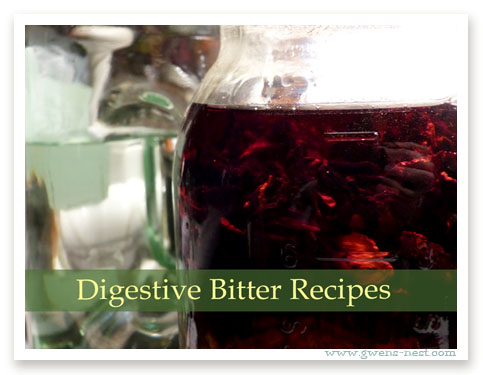
We’re talking digestive bitters recipes today, in part III of this series.
- In Part I, we talk about why you may really want to look at digestive bitters if you are needing to use probiotics, enzymes, or if you have weak or compromised digestions.
- In Part II, I shared some awesome resources to learn more about digestive bitters, and also shared brands and where you can buy pre-made blends.
Today, I’ll show you how easy it is to make a tincture, and I’ll share my own digestive bitters recipes. We’ll also talk about dosing, when to avoid digestive bitters with caveats and options for nursing and pregnant Mamas, and I’ll link to a couple more digestive bitter recipes that you may want to try.
Finding The Right Fit
The real benefit of making your own digestive bitters recipes is that you can tailor make them to suit your needs. How do you know which herbs will be a good fit? One way is to look at the indications or symptom set of each herb, but I find the most effective way is to actually taste a little and see how your body responds to the flavor/herb overall.
Here, I’ve chosen orange peel and three classic bitter herbs, and I made a quick hot water infusion (tea) with the dried herb.
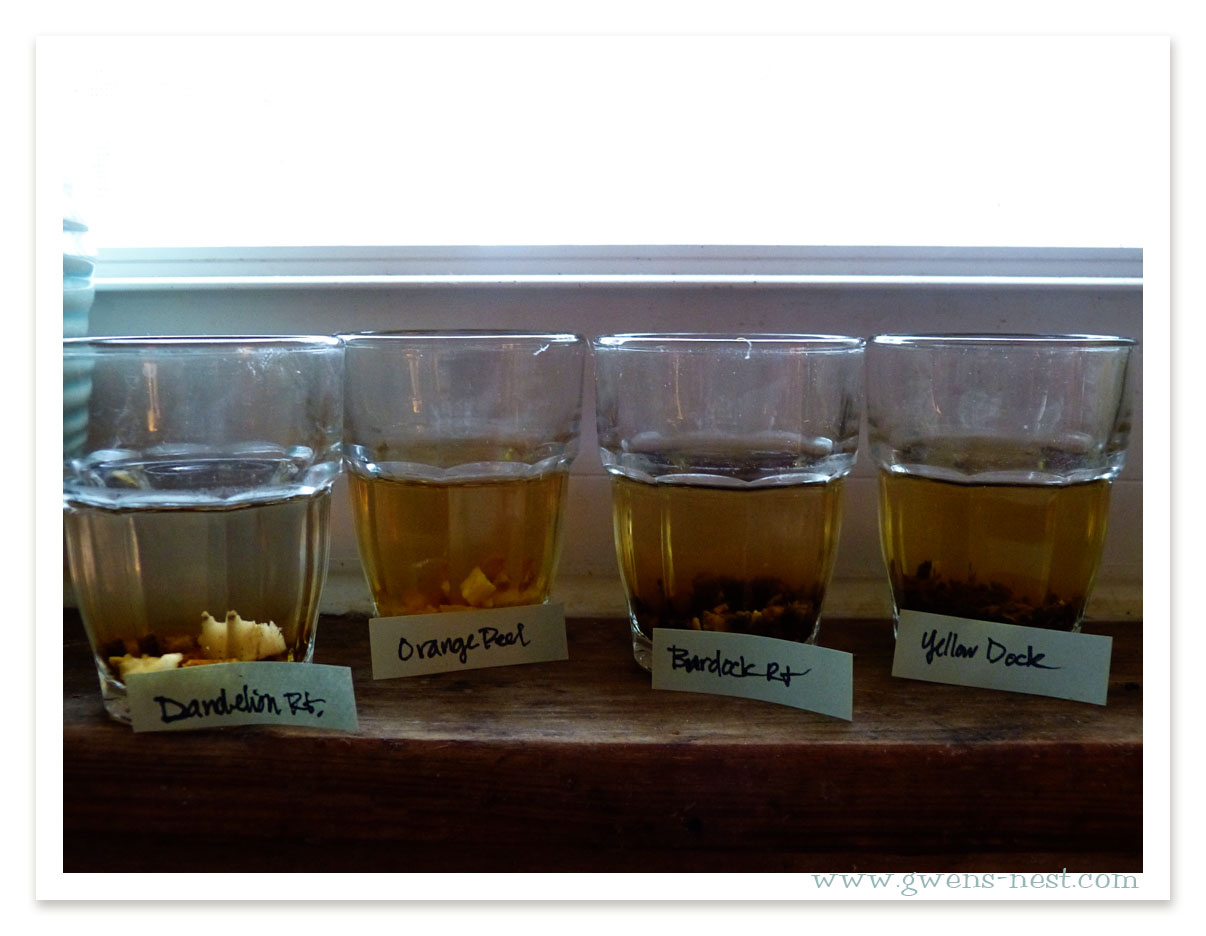
I found that I really responded well to the dandelion, orange peel, and burdock…all were bitter, but not repulsively so. However, the yellow dock was VERY unpleasant to the point of being vile. I felt like it tasted like bug guts. Remember how your hands smell after catching lightening bugs? THAT.
Of course, my kids wanted to participate in my mad science experiment, and I was surprised by the results. My kids didn’t react the way I did with the yellow dock, and were happy with all 4 of the herbs. Though not kool-aid sweet, the flavors were not repulsive to them.
In researching yellow dock, I discovered that it enhances calcium uptake…something that my body was avidly trying to avoid, since I was dealing with high blood calcium at the time. Pretty cool.
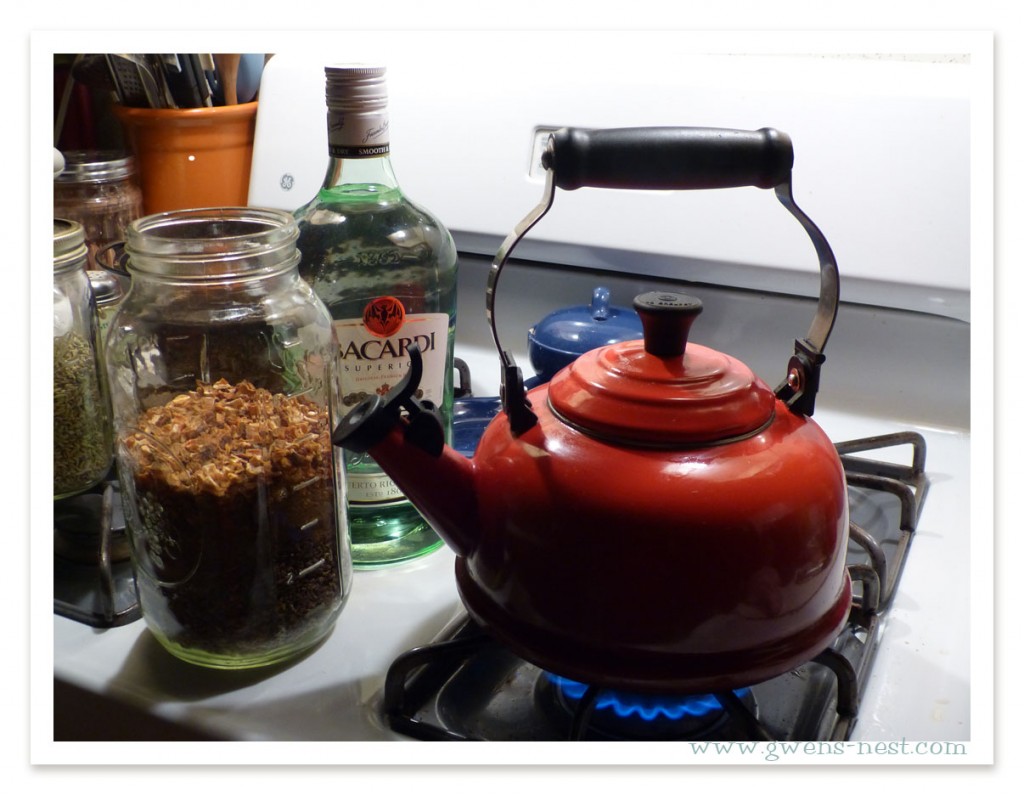 If you’ve never made a tincture before, I can assure you that it’s super simple. If you can boil water and make tea, you can make a tincture. In fact, you start by boiling water. A tincture/extract is made using primarily alcohol as a substrate or medium to extract the herbal properties. Think of it as making a ‘tea’ in alcohol. 🙂 You can also use other substrates to make a tincture, like glycerin or vinegar, but I find alcohol to be very easy to work with and preferable for this recipe.
If you’ve never made a tincture before, I can assure you that it’s super simple. If you can boil water and make tea, you can make a tincture. In fact, you start by boiling water. A tincture/extract is made using primarily alcohol as a substrate or medium to extract the herbal properties. Think of it as making a ‘tea’ in alcohol. 🙂 You can also use other substrates to make a tincture, like glycerin or vinegar, but I find alcohol to be very easy to work with and preferable for this recipe.
Layer your jar loosely with herbs. Fill it one third to halfway full of herb materials (root, flowers, leaves, etc.) according to the blend you want. Dried materials will swell to about double their size, so don’t overfill your jar. Halfway full is the MAX you’ll want.
The digestive bitters recipes below are done in ‘parts’ and not standard measurements. But don’t freak out…it’s really easy to figure parts. The main benefit is that you can really tailor these recipes to any size container, simply by using a smaller or bigger unit of measure. I.e. use a T for a small recipe, and a 1/2 cup to 1 cup ‘part’ for a large batch. I give you thorough instructions on this in the printable digestive bitters recipes below.
If you’re wanting a one stop shop for herbs, I highly recommend Mountain Rose Herbs. They have a huge selection of herbs and even tincture containers. I also love to shop at Savvy Teas & Herbs as well.

click the mountain rose herbs link to enter their site

When your water comes to a boil, dump in about a half cup to a cup…just enough to moisten and ‘wake up’ the dried herbs…this helps them release their properties into the alcohol a bit quicker. Next, you simply fill the jar with the high proof alcohol of your choice.
I’ve used cheap Vodka. It made my tinctures (to quote a friend) “taste nastier than they needed to.” I have switched to rum, and it’s a nice difference. I’ve used cheap, but I really prefer a mid-grade to nicer rum for smoother flavor. This is Bacardi Rum. Notice how it’s clear going into the jar. Remember that when you see the last picture.
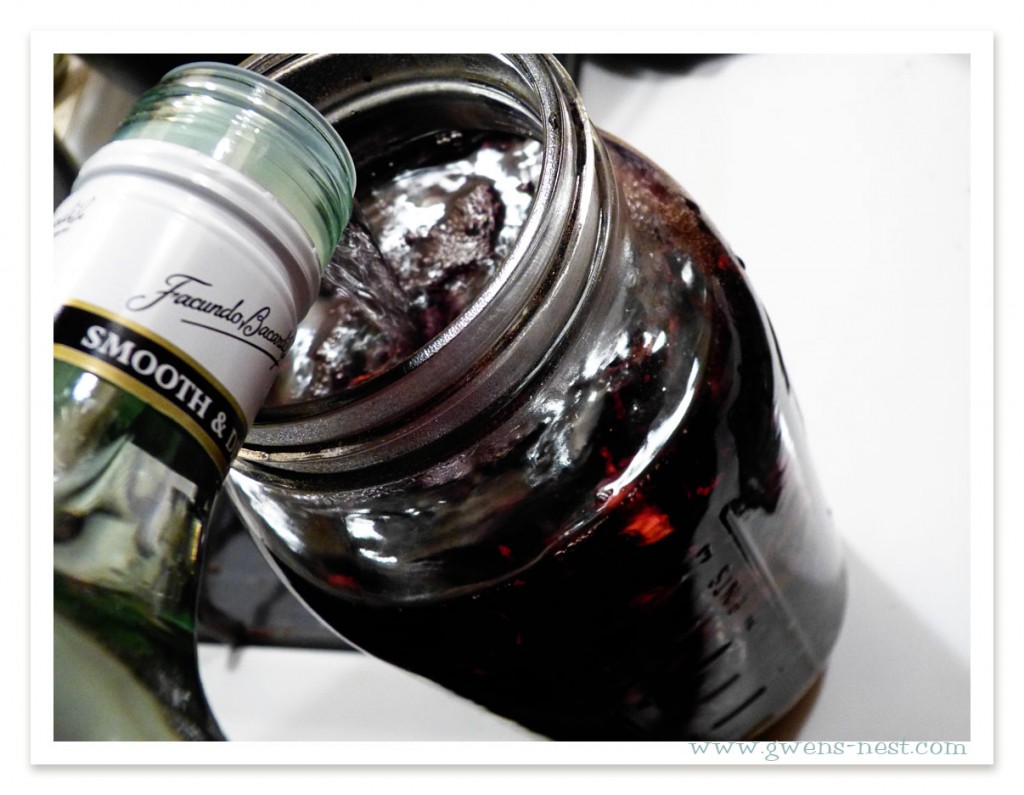
Now, if you are really into herbs, there are courses you can take about which proof of alcohol to use for which types of herbs. But I’m a KISS girl (Keep It Simple or I feel Stupid). So this is my rule of thumb: buy a good 80 proof rum and use it for tinctures. It’s a great ‘all purpose’ choice.
80 proof means that it’s 40% alcohol and 60% water, so the water and the alcohol are both going to extract different components of the herbs. This is a good thing…your herbal tincture will have a good range of nutrients, which are usually the water soluble components and alkaloids, the bitter/medicinal properties that are the powerhouse of an herb.
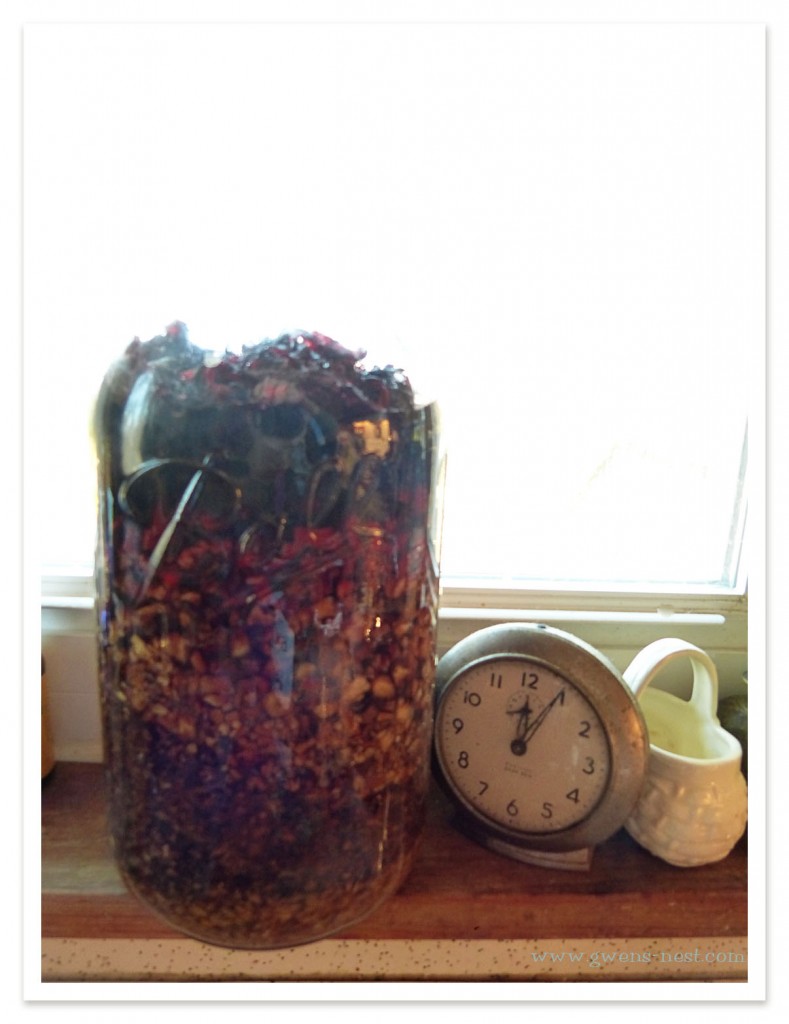 This is the jar of herbs the next day. I wanted you to see how much the herbs have expanded overnight. I had to add more rum. You want the herbs to be submerged under the alcohol.
This is the jar of herbs the next day. I wanted you to see how much the herbs have expanded overnight. I had to add more rum. You want the herbs to be submerged under the alcohol.
I prefer a plastic lid to seal up my tinctures. The metal lids have a tendency to rust. I’m using half gallon wide mouth canning jars for this batch, because I’m making enough to share. Label your jar with the tincture name and date, and store in a cool dark place for 3-6 weeks. You can shake it if you remember.
Now there are many schools of thought on how long to let a tincture sit, but I’m of the school of thought that if the tincture comes out looking nice and dark, that you’ve ‘caught’ some good stuff in there. I frequently will pull off some of the tincture (strain it off of the batch) and use it even before it’s officially ‘done.’ 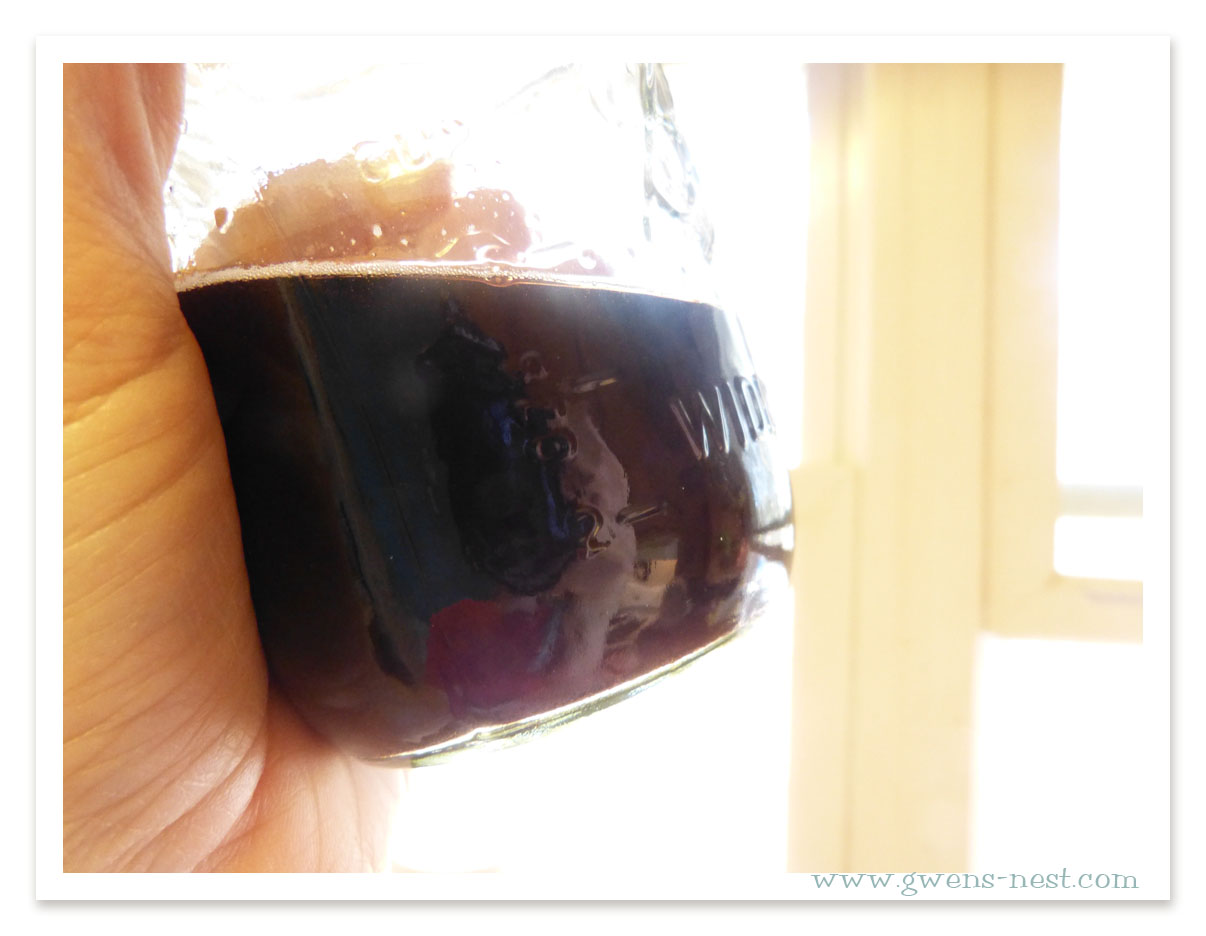
Look at that lovely, dark brew! After straining, I will store it in a dropper or small glass spray bottle for dosing. Tinctures last for years. They are a very potent method for extending the life of fresh or dried herbs.
So, that’s how I make a tincture. I share a quick photo tutorial on my unconventional method of straining over here in the elderberry recipes post if you want to take a look.
Digestive Bitters Recipes & Pin
Now for my digestive bitter recipes…I have two to choose from.
- 1 cup or less boiling water
- 80 proof decent quality rum to fill your container
- 1 part yellow dock root
- 1 part dried hibiscus blossoms*
- 1 part dried orange peels
- 1 part burdock root
- 1 part dandelion root
- Decide how much tincture you want to make, and choose a jar that's roughly double that volume.
- Choose a unit of measure that will fill the jar ⅓ to ½ full of herbal material. My jar holds about 8 cups total, so I want between 3 and 4 cups total. (The herbs will swell a LOT when you add liquid.) A one cup measure would be 5 cups...too much material. A half cup would only give me 2½ cups of herbs. I'd be better off choosing ¾ cups as my unit of measure, which gives me 3¾ cups of dried materials. Perfect.
The beauty of using a recipe with parts is that you can scale the unit of measure to any size jar...even using half teaspoons if you desire a very small jar of tincture. - Add your herbal material to the jar.
- Put a kettle of water on to boil, and when it's boiling add a few 'glugs' of water...really just enough to pre-moisten the herbs a bit. This just wakes up the herbs and speeds the process in the alcohol.
- Fill the jar to the top with 80 proof rum.
- Seal jar with a plastic lid, and sit in a dark, cool place.
- The next morning, check to make sure that the herbs are still submerged under the rum. They wil have swelled quite a bit. Add more rum as needed to cover the herbs.
- Allow mixture to steep in a cool dark place for 3-6 weeks (although I will strain and use some early on.)
- Strain by placing a mesh strainer over a bowl with a pouring spout. Line strainer with a tea towel and add a paper towel over the tea towel.
- Pour finished tincture into the towel lined sieve, and allow it to drain over the bowl.
- When it's mostly drained, gather up the towel and begin to twist the top and squeeze the herbs to press the remaining liquid out of them.
- Toss spent herbs (the paper towel lining makes this much easier).
- Store tincture in small glass dropper jar or sprayer bottle (available on MountainRoseHerbs.com). Tinctures last for up to 2 years.
- 1 cup (or less) boiling water
- 80 proof decent rum to fill your container
- 2 parts burdock root
- 1 part dandelion root
- 1 part fennel
- 1 part licorice root*
- ½ part dried orange peel
- Decide how much tincture you want to make, and choose a jar that's roughly double that volume.
- Choose a unit of measure that will fill the jar ⅓ to ½ full of herbal material. My jar holds about 8 cups total, so I want between 3 and 4 cups of herbal material. (The herbs will swell a LOT when you add liquid.) I have 5½ total 'parts' in this recipe. A one cup measure would be 5½ cups...too much material. A half cup would only give me 2¾ cups of herbs, which is a bit shy. I'll move to the next size up, and go with a ⅔ cup 'unit', which will give me 3⅔ cups of herbs. Perfect.
The beauty of using a recipe with parts is that you can scale the unit of measure to any size jar...even using half teaspoons if you desire a very small jar of tincture. - Add your herbal material to the jar using the unit of measure that you selected.
- Put a kettle of water on to boil, and when it's boiling add a few 'glugs' of water...really just enough to pre-moisten the herbs a bit. This just wakes up the herbs and speeds the process in the alcohol.
- Fill the jar to the top with 80 proof rum.
- Seal jar with a plastic lid, and sit in a dark, cool place.
- The next morning, check to make sure that the herbs are still submerged under the rum. They wil have swelled quite a bit. Add more rum as needed to cover the herbs.
- Allow mixture to steep in a cool dark place for 3-6 weeks (although I will strain and use some early on.)
- Strain by placing a mesh strainer over a bowl with a pouring spout. Line strainer with a tea towel and add a paper towel over the tea towel.
- Pour finished tincture into the towel lined sieve, and allow it to drain over the bowl.
- When it's mostly drained, gather up the towel and begin to twist the top and squeeze the herbs to press the remaining liquid out of them.
- Toss spent herbs into the garbage- the paper towel lining makes this much easier.
- Store tincture in a cool dark place. To use, I fill a small glass dropper jar or sprayer bottle (available on MountainRoseHerbs.com). Tinctures last for up to 2 years.
Dosing Digestive Bitters
The rule of thumb is that you want to coat your tongue with the flavor, and experience the taste of bitter to really get good effect from them. It’s the taste of bitter itself that triggers the digestive response and enhancement. Your reaction to bitters may be different that how someone else responds, so the important thing to remember is to tune in to your body’s response. If you respond strongly, start small and work your way up to 1/4 t. dose per meal, or when sugar cravings hit. You can dose up to 8 times per day. You can pour from a bottle into a tiny cup, or use a dropper, or even use a little glass spray bottle. For the small spray bottles, use about 6 spritzes on your tongue either before or after a meal, or half of a dropper. I use about 3-4 sprays for my kids. And there is a rule of thumb for when to dose:
Dose before eating if your digestive issues are from the ribcage down…issues like constipation, intestinal burning, chronic loose stools, or skin breakouts, then you want to send the bitters into action prior to eating to get the digestive tract primed.
Dose after eating if your digestion problems come up from the stomach, like belching, acidic stomach, and burning in the esophagus.
Using bitters often not only gives an immediate digestive response, but it also works on a deeper level to build and enhance digestive response over time. So commit to trying it for a month.
Herbs, like pantyhose are not a one size fits all situation. If you’re struggling after a couple of weeks to adapt to the bitter flavor, and you seem to be really reviled by the taste, then it’s possible that you may have an herb in the mix that is not a good fit for you. (Remember my run in with yellow dock?)
When To Avoid Digestive Bitters
Those with ulcers are advised not to use bitters, as they can aggravate an ulcerated stomach.
Pregnant & nursing Mamas have to use some caution when choosing a bitters formula. Most commercial formulas contain herbs that are contraindicated in pregnancy or nursing. However, the great news is that many nursing support teas contain LOTS of bitter herbs. Mountain Rose Herbs has a Nurse Me Rhyme Tea that is loaded with great digestive herbs. And now, Urban Moonshine carries these Chamomile Digestive Bitters that are pregnancy safe. Mountain Meadow Herbs has a Maxi Milk tincture for nursing Mamas that would do double duty as digestive bitters as well.
More Digestive Bitter Recipes:
Here are a few more interesting bitter recipes and resources
- A yummy chewable bitter blend recipe, w/ fennel, ginger and orange peel. http://www.herbmentor.com/an-after-meal-digestive-treat/
- Mountain Rose Herbs has a very simple digestive bitter tincture recipe-http://mountainroseblog.com/dandy-tummy-bitters-recipe/
- And if you’re really interested in exploring bitters, there is this recipe book on Amazon : http://www.amazon.com/Bitters-Spirited-Cure-All-Cocktails-Formulas/dp/1580083595
Have you tried digestive bitters? What are your thoughts and results?
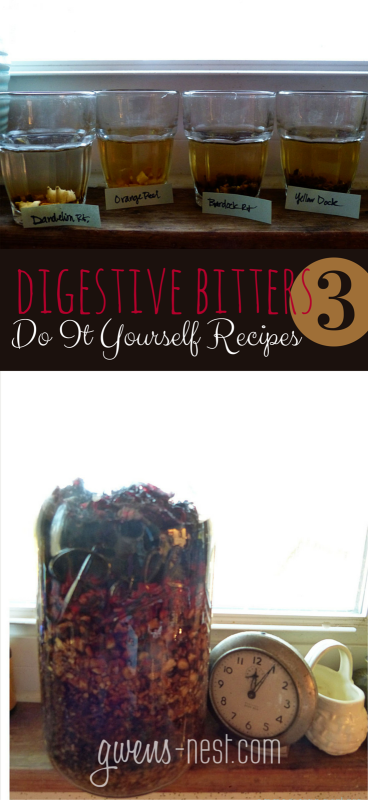
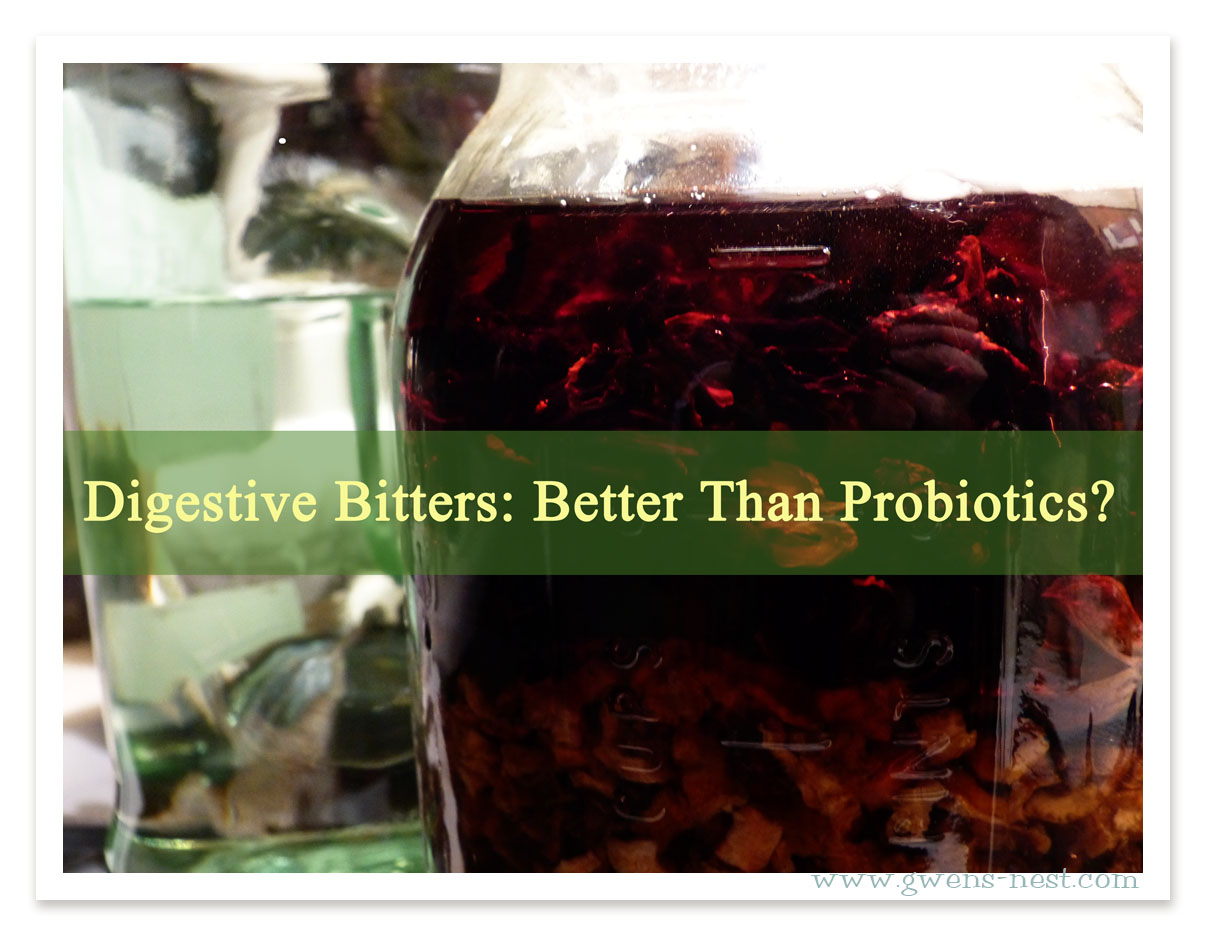
Thanks so much Gwen! I will definitely give this a try. I cross referenced different herbs that were listed as good for digestion, liver tonic, stomach, etc. and noted which were on our genotype superfoods list. I’ll give it a go with those first. One of these days maybe I’ll learn muscle testing and further define the beneficial herbs for us.
Way to do your homework, Debbie! 🙂
Thank you for all the good info on bitters. Have you looked into Maria Treben’s swedish bitters herb list? http://www.swedishbitters.com/dry-swedish-bitters-mixture-lesser-100-grams
I was thinking of purchasing and making my own. So there is no “one” special bitters recipe? Just any combination of bitter herbs work well? I’m trying to figure this out. Thanks again!
Hi Debra,
I’ve not heard of the site you posted, but I know that friends of mine have tried swedish bitters and not cared for the taste. They are also known for using senna, which is an herb than can (with continued use) cause the bowels to become dependent on it. So I’d look elsewhere.
Bitter blends are going to vary…though the very basic dandelion bitter is a classic. You really can blend from a variety of different bitter herbs to suit your tastes, symptoms, and constitution.
My friends also said the camphor taste was VERY yucky. 😛
Hi Gwen. Fairly new to THM but have had an interest in herbs for years. In fact through herbs, and the helps of a certified herpetologist (is that the right term?), trained in England, I was able get rid of my endometriosis and Uterine Polypsin , resulting in the pregnancy of our last child, which the doctor said could never happen 🙂 She is 20 now, and I was close to 46 when she was born. Oh, back to point. I read about silymarin and was wondering what brand you used, and second I do not have ulcers but very close to it. Should I, too, avoid the bitters? Thank you for all your hard work!! Judy
Hi Judy,
Wow! Cool history! I wish I could sit with a cup of tea and hear the long version. 🙂
I’d research ulcers and especially the role of bacteria in ulcerations. That may need to be addressed first.
I use the NOW or Vitacost brand of silymarin or milk thistle extract.
Thanks for your comment!
I think you mean “herbalist”. Herpetologists study snakes. 😉
What do you estimate the cost being for making a batch?
Thanks for sharing the recipe. I’m excited to get started! One question…can I give this to my children, considering the alcohol??
That would be a totally personal decision. Some Mamas are fine with the tiny amounts of alcohol, and others choose to use glycerin or even vinegar instead of alcohol for their children’s tinctures. You could also meet in the middle and do half tincture, and half glycerin or vinegar.
Sorry if this question was already asked. But did you dry your own orange peel?
Thanks for posting. I appreciate your time and effort. Is Part 4 done yet?
If I can’t use alcohol, what do I use instead? Would the ratios be the same?
alcohol is preferred here, since we’re wanting it to affect the liver, and the bitter alkaloids are extracted better with alcohol. But if you can’t use it, then try vinegar to extract the herbs. I would use the same recipe/ratio, but warm it on low heat in a crock pot for a day or so, and/or let it sit with the herbs in it for several weeks.
the other alternative might be to drop the tincture into hot water and swish this in the mouth. The alcohol should be gone yeah?
Only a small amount of alcohol is evaporated when added to hot water. So I don’t think that would be a good alternative. You can use vinegar to extract herbs. It’s not *quite* as potent as alcohol, but it works. 🙂
This is so informative and so well written. I had been searching online for information on bitters and nothing quite gave what I was looking for. I really learned so much by reading your series. I can’t wait to go to the herb store tomorrow and make my own. Thank you so much!!!
Thank you, Regina! So glad you enjoyed it! Thanks for leaving such an encouraging comment. 🙂
I agree with Regina! I love your posts and have many of them printed. I am eagerly looking forward to post IV on this topic as I am interested in all the herbs used in bitters. Hope to make my own soon! I have your cough syrup and elderberry syrup in my fridge now. (c:
What kind of vinegar would you use if you prefer not to use alcohol?
Hi Bonnie,
You can use any kind of vinegar, but I really like using the raw kind. 🙂
I have been sharing your article on facebook with those that I think need it. It is a great resource. I found out about bitters a couple weeks ago listening to some one talk about gene mutation and how it is good to use bitters instead of Betaine HCL. I have ordered a number of products but have yet to get them. I have had digestive issues for a very long time. I used to have a stomach of steel when I was younger but not the case any more. I look forward to trying out the bitters and watching them improve my life.
Bitters can be a really important piece of the puzzle in getting your digestive fire back. Thanks for sharing, and here’s to your improving health.
Would raw apple cider vinegar be a second best choice if I prefer not to use alcohol ??
Would you recommend any particular herbs to go with Hawthorne Berry ? I have heard that Hawthorne Berry is recommended for stagnant digestion.
Thanks Gwen in advance for your timely reply !
Alcohol pulls out the strongest properties from the herbs, but you can use apple cider vinegar. I think it would be a distant second, but you’d still get benefit from it. 🙂
With herbs, you want to look at the person taking it to determine which ones are the best fit, and I’m really not qualified to do that. But the herbs in the digestive bitters recipes post are all very useful and work well in digestive combinations.
Thanks for the information on making Swedish Bitters.
I don’t know much about alcohol, but isn’t rum sweeter than vodka? Wouldn’t that interfere with the bitter flavor that you’re going for?
Nope…it’s not sweet at all. 🙂 Just less nasty tasting than vodka.
LOVE Bitters! I’ve made your 1st recipe many times ~ and yes! Sometimes without the Yellow Dock!
Last time I made it with Chamomile too. I have fun adding different flavours so I normally make each tincture separately and then mix afterwards in a small amount to see what I think of the taste. Needs to be bitter but love trying to create a yummy
before meal or after dinner digestive aid.
Thanks for the super article. We are on the same track with bitters.. It’s a wonderful thing!
green blessings. Carol
Oh, I’m a kindred spirit in enjoying the experimentation with all of the flavors. It’s kind of fascinating to play with bitter, instead of the typical American sweet or savory combos. 🙂
I am going to try my hand at making a tincture. I haven’t been diagnosed with leaky gut, but by doing some research I believe I have this. I was doing research on herbs that help leaky gut and they are slippery elm, marshmallow root, licorice root, yarrow and plantain. Now can these be put together in the same tincture? Thanks.
Hi Jen! Technically, yes. However, tinctures tend to pull out the components that are alcohol soluble, and some of the really useful compounds are better served with simple water extraction like teas. So you want to get to know each herb, the history of use (is it more useful as a tea or a tincture for gut issues?), and also how you respond to each one. Which is why many herbalists go with simples or tinctures of single herbs. Then they can test each one individually, and mix and match as needed.
I know off hand that the properties of marshmallow and slipper elm are best served with water extractions (decoction, tea). Yarrow & plantain can be tinctured effectively, but I’d do a little more digging on the plantain and maybe look at using that in a tea as well. 🙂
My gall bladder was removed 2 years ago after a lifetime of good health (I’m 65 going on 37). I make all natural skin care products because I’m sensitive to lots of things, even through my skin. I distill many of my own oils. After spending all night in the bathroom last night after a steak dinner, I’m going to try your bitter tincture in the future. I have been into holistic remedies since I was 14 but never got into tinctures. Ill try ox bile and Livatone(sp?) too. New horizons! It always amazes me when someone shares so much with others, thank you!
GO CELTS!!!
Great site you’ve got here.. It’s difficult to find excellent writing like yours nowadays.
I truly appreciate people like you! Take care!!
Thank you, thank you. 🙂
I’m just wondering how to make a tincture with vinegar instead of alcohol. Do you have any resources for that?
I don’t. But you’d simply use vinegar as the menstrum instead of alcohol. Applying heat or letting it go for a lot longer will help with the strength, because it won’t be as concentrated as an alcohol extraction.
In the second recipe that calls for fennel, is it fennel seed? The fennel I found on Mountain Rose was fennel pollen and seed.
Yes…fennel seed.
Hi Gwen, thanks so much for this site and the info about bitters! My family and I have been on GAPS for about three years trying to get back good health, and my youngest still has issues with his pancreatic enzymes. Was thinking about Betaine HCL until I followed a path labelled digestive bitters and ended up here! I would love to try them for him. I am exited about your recipes and will attempt to try them. Question: do you need to dry the orange peel first, or is it ok to just peel it off the orange and put it in the rum?
You can use fresh orange peel…no need to dry it first. 🙂
this is a great help thank you Gwen! My doc prescribed bitters to help my body to increase pancreatic enzyme production. I have been buying one but it is very expensive, I am looking forward to trying one of these recipes! 🙂
I have a question I didn’t see addressed. If it has been asked, I apologize.
My baby (9 months) is showing signs of eczema. I haven’t had her tested.
But, I know ultimately eczema stems from the gut.
I’m just now researching the GAPS diet, and trying to introduce gut healing first foods.
I stumbled on this article, and I’m interested in making this tincture for my family.
I’m wondering if this would be safe to give my baby?
You mention giving it to your children, but I wasn’t sure on the ages.
I have 4 children ages
5, 4. 2, and 9 months
Thanks
Hi Kala,
I’m not crazy about using herbs with infants under a year old. Their digestive systems are still immature, and herbal preparations can be pretty dang strong, as well as strong tasting. I would use things for myself and pass along benefits to my nursling, or use gentle herbs as teas or direct edibles (i.e. nettles in stew), but would not use strong alcohol tinctures with young ones. There is a company called Trilight that makes child friendly glycerine tinctures that you could look into.
I have friends who have had great success in simply avoiding gluten for controlling eczema. I would probably try eliminating potential allergens as my first approach. 😉 Bless you!
Can I make the first digestive tincture recipe without the yellow dock root? As it was unavailable when I ordered herbs. Thanks
You certainly can…use what’s available. 🙂